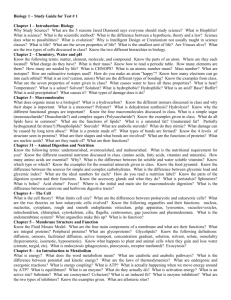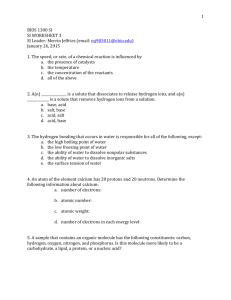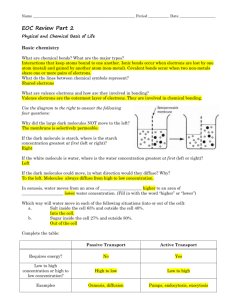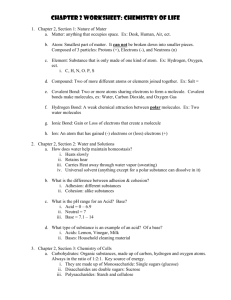Sem. 1 TEST REVIEW - LeMars Community Schools
advertisement
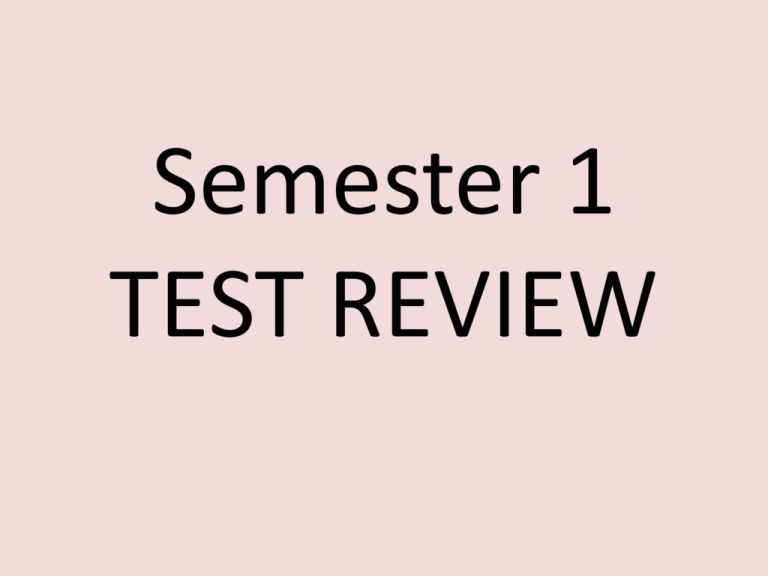
Semester 1 TEST REVIEW This is a comprehensive test review • This is a review over the info. that we have covered in this first semester of biology. • Therefore: I cannot guarantee we’ll cover EVERY question on the final. • Test questions will not go in order of chapters on the actual test. Details to add to your review sheet… • Page numbers are given on several slides to help you to quickly find the information that you may want to review. • Use them as needed. • Write down additional information as we discuss and go over each topic. • Ask questions about information that you don’t remember, want clarification on, but wait for the slide to finish first please. The details… • 110 mult. choice questions • You may use 1 side of a piece of notebook paper, 8 1/2 x 11 inches as a “cheat sheet” • Your cheat sheet must be handwritten, (not typed), have your name on it, and will need to be turned in with your test. Ch. 1 • What is the goal of science? To understand the ___________ around you. • Scientific Method 1. State the problem 2.Make Hypothesis 3.Experiment 4.Collect and record data 5.Come to a conclusion • Experiment –Control Group•Stays the same –Experimental Group •(variable), it’s what changes *Measurements (basic units) p. 14 • Length –m • Mass- kg • Volume- L • Temp- degrees C *Study prefixes, metric system *Metric system is based on powers of… 10 Lab Safety Inside cover of your book, go over Single most important rule is… • Follow the teachers directions. Characteristics of Life • Made of cell(s) • Reproduce • Growth • Use energy • Respond to stimuli Homeostasis • Known as the _______________ __________. • Ex. Water levels Blood sugar level Body temp. Need to know… •Observation •Theory •Hypothesis •Ethical vs. Unethical behavior in science Ch. 2 • Chunk words- to get the meaning Ex. Zoology (zoo=animal, ology=study of) Branches of biology •Nanotechnology p. 34 •Biomimetics p. 35 •Genetic Engineering p. 33 –Ex. Bt corn, you can use less… pesticides Branches of bio. (cont.) • Assistive Technology p. 32 • Battlefield medicine p.32 • Biomolecular materials p. 35 p.30-31 Low Tech solution for Cholera • Read over the info. on p. 30 for Health in the 21st Century. • A sari is mentioned on the test, know what it is and how it is used. • P. 31, look over the info. on vaccinations. How have vaccinations changed our world population? • Microscopes –Compound light-(we use these) –Electron microscopes- • T.E.M.- bounces electrons off an object • S.E.M. -a scanning beam of electrons moves back and forth Ch. 3 Properties of Matter • Characteristic by which they are identified • Should describe to the 5 senses • Describe physical properties, length, mass, volume • Physical and Chemical properties; –Physical, can be observed and measured –Chemical, when a substance is permanently altered. • Structure of ATOM Nucleus - protons (positive) -neutrons (neutral) Energy levels - electrons (negative) Atom cont. *Atomic Number= number of protons = number of electrons too! *Mass number= # of protons + # of neutrons = p+n ?-What is the smallest particle that can still be identified as an element? • Elements and Compounds E- Pure, made of only 1 type of atom C-Made of 2 or more elements p. 51-52 • Radioactive isotope- used in medicine Isotope = different number of neutrons Radioactive= Greater tha n 83 on periodic table are radioactive. • Chemical Reactions –Any process where a chemical change occurs –Usually use equation… Ex. O2 + 2H2 2H2O Know the reactants and products: R P Ch. 3 Properties Of Water • When water freezes it expands • It is a bent molecule; + on one end, - on other –This makes it good as dissolving –“Universal Solvent” BENT WATER MOLECULE In the human body, nearly 60 % is water • Mixtures -2 or more substances mixed but not chemically combined. -Ex. Soil, air, salad • Solutions-solute dissolved by solvent - Ex. Salt water, sugar water Acids & Bases • Acids, give off H+ -low numbers • Bases, give off OH-high numbers pH Scale Stronger Acids 1, 2, 3 7 10, 11 14 Stronger Bases Neutral (Ex. Water) • Organic vs. Inorganic O- If it has carbon (is or was alive) I- If it doesn’t have carbon, wasn’t ever alive Note: Carbon is reactive, so bonds very well. 4 Compounds of Life 1.Carbohydrates (sugars)p.60 Monomer=monosaccharides Polymer = Polysaccharide *Give you energy 2. Lipids (fats, oils, waxes)p.61 Store energy Chemical messengers Form membranes 3.Proteins p.62 Monomer= Amino Acid Polymer=polypeptide Ex. AA+AA = Dipeptide, AA+AA+AA=Tripeptide *Enzymes are proteins, proteins help cells move 4.Nucleic Acids p.63 (RNA & DNA) Monomer=Nucleotide * Job is to store hereditary info., or to be the blue prints for a new organism. Ch. 5 Populations & communities Know terms: • Population p. 103 • Carrying capacity p.105 • Exponential growth p. 104 – J-shaped – graph example is the human population • Logistic Growth p. 105 – S-shaped Abiotic vs. Biotic • Abiotic = Non living • Biotic = Living Human Population… •Has now exceeded – 6 billion *As of 1/7/11 6.89 billion Relationships Know terms & examples for each: Predator, prey Co-evolution Parasite, host Symbiosis Mutualism Commensalism Keystone species More terms to know… • Niche • Fundamental niche(where it COULD survive) • Realized niche (where it actually DOES survive) Ch. 7 Cells Cell Theory -All cells come from cells -Cells are basic unit of life -All living things are made of cells. Scientists p. 151 -Van Leeuwenhoek, first microscope -Hooke, named the cell -Schleiden, all plants made of cells -Schwann, all animals made of cells -Virchow, all cells come from cells • Cell Structure (found in MOST cells) -Nucleus -Cytoplasm -Cell membrane • Prokaryote= no nucleus (bacteria) • Eukaryote= has a nucleus • Organelles (p. 156) Smooth ER-transport system Rough ER -has ribosomes on it, makes and transports proteins too. Mitochondria-power house Golgi apparatus- packages, sorts and sends substances • Nucleus-nuclear envelope (covering) -nucleolus-made of RNA & proteins -chromosomes(made up of DNA) Plant vs. *cell wall *Chloroplast *lg. water vacuole *plastids Animal Cell *lysosome • Diffusion-molecules move from high to low concentration. –Osmosis, diffusion of water –Hypotonic, low amount of solute –Hypertonic, high amount of solute –Isotonic, equal amount of solute in & outside cell *Facilitated diffusion-NO energy used Ex. Sodium/Potassium pump, pumps K+ into the cell and Na out of the cell. *Active transport-uses energy -Pinocytosis=“cell drinking” -Phagocytosis=“cell eating” Ch. 9 Photosynthesis & Cellular Respiration • 3 Scientists Van Helmont Priestly Ingenhous • CO2+H2O C6H12O6+ O2 • Know where this occurs – Thylakoid=Light Reaction – Stroma= Dark Reaction • Light Reaction • Uses: H2O Produces: O2 ADP ATP-(fuels Dk.Rxn) NADP+ NADPH(fuels Dk. Rxn) *Dark Reaction a.k.a. “Calvin Cycle” p. 206 *Glycolysis –Where does this occur? CYTOPLASM -End product is pyruvic acid/pyruvate • Cellular Respiration p.208 –Occurs in mitochondria • Fermentation p.212 –No oxygen=anaerobic –2 kinds •Lactic acid & Alcoholic

